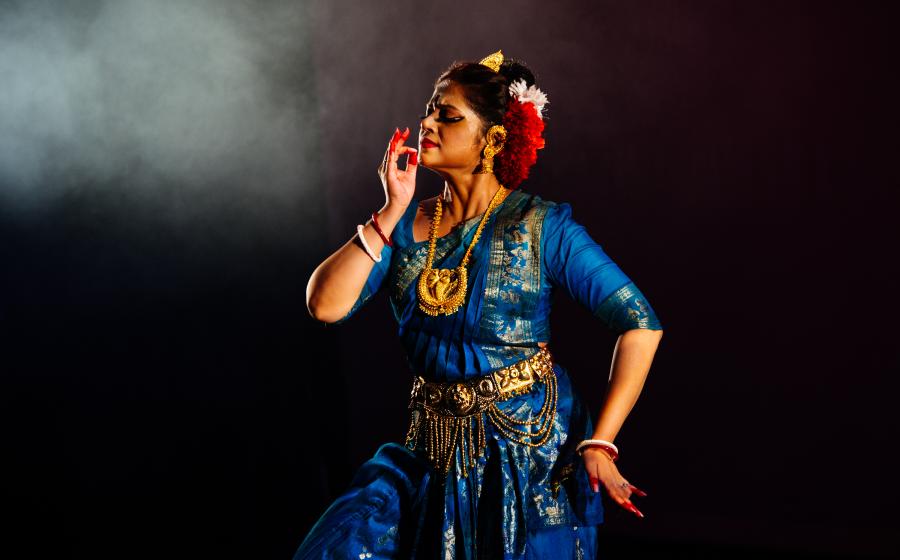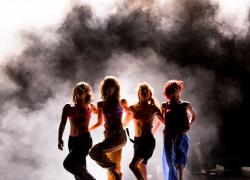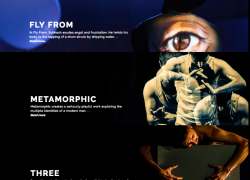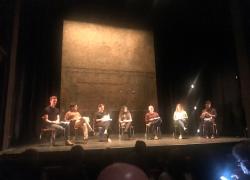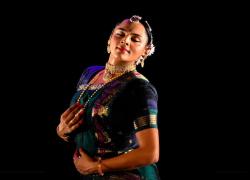Hemantika Festival
The Bhavan, London
19 November 2023
Reviewed by Sanjeevini Dutta
Now in its eighth year, Day Two of the Hemantika Festival, produced by Sujata Banerjee Dance Company, brought audiences four dance sections: three solos and a group piece. The template was the familiar bringing together of different classical dance styles. Over the course of the evening, we were introduced to Gaudiya Nritya, a cross between classical dance and folk theatre by visiting artist Rachel Priyanka Perris from Bangladesh.
The Bhavan was sadly not filled to capacity as we settled down on a Sunday evening of the World Cup Cricket Finals in which India had unexpectedly lost.
The opening by kathak dancer Anuradha Chaturvedi started promisingly enough with a that - the slow unfolding of rhythm in which the dancer spoke of evoking the ‘still’ aspect of Shiva and contrasting it with liveliness of Shakti, the female energy. The finishes to the sequence were impressive in the poses taken with open arms, some with dropped level on the knee. Trained in the Lucknow gharana, Chaturvedi undoubtedly had grace of limbs, particularly of the arms and upper body. However, the technical sections of tukras and tatkar felt underpowered.
The Surdas pada which conveys the devotee spotting Krishna in all corners including the corner of the smile was performed with feeling. The accompanying young musicians kept the pace and lyricism. (Vocals- Prachi Ranade, tabla-Dhanraj Persaud, harmonium- Siddhiiee Kapshikar, music composition Hriday Desai)
Divya Ravi with vocalist husband Sharan Subramaniam and musicians Bala (mridgangam) and Vijay Venkat (flute) created Preyasi (‘Beloved’) specifically for the Festival. The piece is based on the twelfth century Sanskrit poem, The Geeta Govinda, portraying the relationship between Radha (the devotee) and Krishna (the object of devotion). It describes the journey of Radha from the flowering of love in Spring to the phases of searching, finding, being devastated by discovering unfaithfulness; to raging, regretting, forgiving and finally uniting with Krishna. The emotional landscape covered requires an extraordinary degree of skill and aesthetic sensibility. Ravi surpasses all expectation. She can conjure up the enchanting forest in one line describing the creepers; she can display rage with one lift of the finger; she can seduce with a backward glance or hold stillness for a moment’s eternity.
The same movement of grinding sandalwood paste in Ravi’s hands looks unique and original, as if having mastered the hastas from the Natya Shastras she no longer needs them. Each gesture is imbued with a significance that goes beyond the physical. The Jayadeva astapadis (songs based on stanzas of eight couplets) have been choreographed by our great gurus and we have seen many versions. Divya Ravi’s choreography, in which she combines sections of each of the eight astapadis, holds a candle to the best of them. Finally, the sympathetic accompaniment by three excellent musicians make Preyasi an unforgettable experience.
Sujata Banerjee choreographed for the company dance ensemble of four, a piece based on Goddess Durga, whose main festival is celebrated in the autumn (‘Hemant’). Verses describe the power and the awesome side of her nature together with the fierce maternal love. The use of the back, of powerful foot patterns, swift pirouettes and changing formations made it a watchable and uplifting piece.
Lastly, Rachel Priyanka Perris from Dhaka performed three items from the repertoire of Gaudiya Nritya. This dance form, which has been reconstructed by Dr Mahua Mukherjee from Kolkata, is said to have originated in Gaur, the ancient capital of Bengal, and is a unique combination of music, history, poetry, literature, drama and rhythm. The content of the dance reflects the religious beliefs and practices of the region and since female power is revered in Bengal, it features strongly in dance.
The opening invocation is to Chandi, the fearsome aspect of Durga. Perris enters with a flywhisk in each hand and an upturned pot placed upstage provides elevation to the dancer when she climbs on it. The dancer excels in the portrayal of Chandi/Kali. The hasta of showing the ‘fangs’, twisting the mouth, and rapid eye movements recall a dance theatre form with an earthy quality rather than refined classical sensibility. This is noted as a strength rather than a criticism. The knees are rotated out in a deep sitting position as a base stance; diagonal stretches of the legs give variation; leaps and high kicks give a tandava (attributed as masculine strength) quality. Rachel Priyanka Perris is like a Kalighat painting come to life. The play of hands and wrists of the torso and hips create the aura of the temptress-seducer Mohini.
The second item is the Ardhnarishwar (Shiva combining the male-female forms), a popular theme in classical dance. The subtler aspects are harder to convey through Gaudiya Nritya, at least at this stage of its development.
The concluding item in which the evil Kansa takes the form of a wet nurse Pootna who applies poison to her breasts as she suckles baby Krishna, gives full reign to Perris' dramatic skills. She conveys each character with relish and her portrayal of a caring nanny figure whose intentions are evil is even amusing. The piece builds up to a crescendo as life is sucked out of Pootna whose crazed figure tears around the stage losing control before finally collapsing.
The evening offers a mixed experience with the premiere of Preyasi being the highlight. This creates an unevenness to the evening. Each section is different and does not necessarily build on what has gone before. However, in providing a platform for classical dance and on this occasion introducing audiences to an unfamiliar form, it fulfils an important function.

